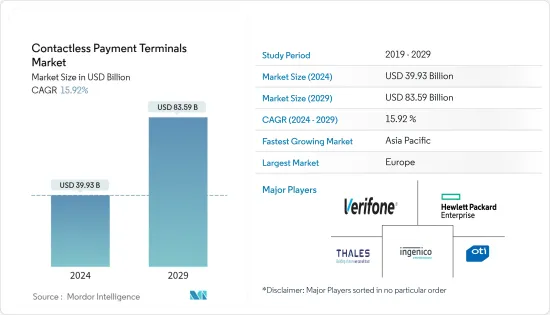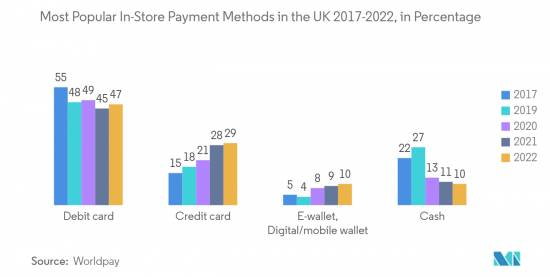PUBLISHER: Mordor Intelligence | PRODUCT CODE: 1404080

PUBLISHER: Mordor Intelligence | PRODUCT CODE: 1404080
Contactless Payment Terminals - Market Share Analysis, Industry Trends & Statistics, Growth Forecasts 2024 - 2029

The Contactless Payment Terminals Market size is estimated at USD 39.93 billion in 2024, and is expected to reach USD 83.59 billion by 2029, growing at a CAGR of 15.92% during the forecast period (2024-2029).
The global landscape of payments and transactions is changing rapidly, owing to the growing enterprises and consumer propensity toward digital transformation and the proliferation of smartphones. Technological advancements in smartphones, digital payment cards, and retail POS terminals fuel market growth.
Key Highlights
- More and more countries are moving toward becoming cashless economies, thus encouraging digital payment providers by incentivizing their consumers' digital forms of payments. In addition, growing contactless card transactions worldwide drive the demand for contactless payment terminals in various end-user industries.
- Contactless payments are gaining significant traction due to their convenience and preference. As a result, various wearable device manufacturers are incorporating near-field communication (NFC) technology as a standard into most devices to provide greater convenience by removing the need to fumble with a wallet, purse, or phone.
- In addition, the global consumer inclination toward payment methods involving smartphones is increasing in the form of contactless payment methods at POS systems, owing to which card and financial service providers are either offering their card solutions on smartphones or via third-party vendors.
- Additionally, the rising financial frauds worldwide have influenced government regulatory bodies to secure payment transactions over the past few years. With customers demanding safe and reliable digital transactions, the need for using secure payment processes has increased. Therefore, these regulatory bodies have positively impacted the adoption of POS terminals. With the increasing mobility trends worldwide, mobile POS systems are gaining traction. With the advent of cashless transactional technologies, POS is expected to witness an increase in adoption rates.
- Moreover, technological advancements are shaping the future of the contactless payment terminals market. Market vendors are focusing on developing payment platforms that are agile and efficient and also increase the penetration and reach of contactless payments. For instance, in February last year, digital payments player Infibeam Avenues Limited (IAL) announced to broaden its payment solutions portfolio by launching a no-hardware contactless mobile point of sale (POS), which will facilitate card payment transactions for small vendors through a tap-on-phone technology.
- During the COVID-19 pandemic, consumers worldwide started finding ways to avoid human contact in order to protect themselves from getting affected. Due to this, the demand for contactless payments has increased, boosting the demand for various contactless payment terminals, such as contactless POS terminals, in multiple industries. In addition, even after the pandemic, the demand for contactless payment terminals is expected to grow rapidly, owing to the proliferation of digital payments in emerging economies.
Contactless Payment Terminals Market Trends
Retail Industry is Expected to Hold Major Market Share
- With the increased use of contactless payment terminals in retail, together with benefits arising from placing them on offer like promotion of sales at merchants and improved customer satisfaction, it is expected to have a strong market share. Retailers provide a contactless payment option to enhance the speed and efficiency of the checkout process, fostering customer loyalty through smoother and quicker transactions.
- Point-of-sale terminals (POS) across retail stores and The primary drivers for this segment are outlets and a preference of mobile wallets to check out from retail stores. The evolution of mobile-based POS (mPOS) includes an card reader connected to a basic ePOS app on a tablet or smartphone, and while Merchant onboarding is simple, where the service is delivered on a 'pay-as-you-go model. In the retail sector, these cases are likely to lead to deployment of Contactless Payment Terminals.
- Market players offer innovative and smart solutions for retailers, expected to drive the adoption of contactless payment terminals in the retail segment. For instance, the previous year, Square, a financial services platform, It's announced to its millions of sellers in the United States that it will be launching a Tap To Pay service for iPhone. In addition, the newly launched Tap to Pay on iPhone enables all sizes of vendors Accepting contactless payments directly from their iPhones without any hardware or additional costs is also available as an application in Square Point Of Sale'siOS point of sale applications.
- Moreover, the growth in contactless debit card and credit card transactions in retail stores and outlets is anticipated to drive the market demand for contactless terminals in the retail sector over the forecast period. For example, the most popular payment method in the UK last year was debit cards which accounted for 45 % and 28 % respectively of all payments made at POS terminals according to statistics from Worldplay.

Europe is Expected to Hold Significant Share in the Contactless Payment Terminals Market
- The European region is expected to hold a significant market share over the upcoming period, owing to the changing payment landscape for various reasons: changing consumer habits, regulatory developments, innovation, and the COVID-19 pandemic. Moreover, the broader adoption of contactless payment terminals in different end-user industries is witnessing significant growth, further driving the market in the coming years.
- In Europe, consumers' wearable devices for payments continue to take off as they grate this relatively new payment method into their daily lives. For example, a ring, a wearable device, a bracelet, or a smartwatch, has Near-field Communication (NFC) capabilities. There exists 'active' and 'passive' wearables. The transaction which can be authorized by entering the PIN code on the payment terminal, just as with a plastic card, if you have your passive wristwatch that is like a ring. When you wear an active watch, such as a smartwatch, the PIN is inserted on your device itself and payments can be made using one tap.
- Additionally, amidst the COVID-19 situation, contactless card limits across Europe grew substantially as contactless payments were promoted across the continent. More and more consumers in the region are moving toward contactless payments after the pandemic, which is further expected to drive the market. For instance, according to European Central Bank (ECB) report, contactless card payments at the POS increased considerably in three years, from 41% of all card payments in 2019 to 62% in the last year.
- In addition, continuous product innovation by market vendors in the region is expected to drive the market over the forecast period. For instance, in May last year, PayPal Holdings Inc. launched Tap to Pay with Zettle by PayPal for small businesses in the United Kingdom. The new function will enable individual sellers and small businesses to accept contactless in-person payments directly on Android mobile devices without additional hardware and fees.
Contactless Payment Terminals Industry Overview
The contactless payment terminals market is consolidated because only some players have a significant market share. Moreover, consumers' need for more awareness toward contactless cards and concern over security issues make market entry challenging for new players. Some of the key players in the market include Thales Group, OTI, VeriFone Systems Inc., Hewlett Packard, and Ingenico Group SA.
- September 2022 - Mastercard, Thales Group, ProvidusBank, and Interswitch announced a new Tap-to-Pay service in Nigeria. The Tap-to-Pay service allows cardholders to make fast, secure, and convenient in-store payments by tapping their NFC-enabled smart device at any contactless-enabled payment terminal.
- March 2022 -With Softpay.io, a mobile payment with contactless cards and mobile wallets application, and A new and innovative softPOS solution, Softpay, which enables merchants to accept contactless payments on Android phones and tablets in the same way as payment terminals without additional hardware, has been launched by Nets, part of Nexi Group.
Additional Benefits:
- The market estimate (ME) sheet in Excel format
- 3 months of analyst support
TABLE OF CONTENTS
1 INTRODUCTION
- 1.1 Study Assumptions and Market Definition
- 1.2 Scope of the Study
2 RESEARCH METHODOLOGY
3 EXECUTIVE SUMMARY
4 MARKET INSIGHTS
- 4.1 Market Overview
- 4.2 Porter's Five Forces Analysis
- 4.2.1 Threat of New Entrants
- 4.2.2 Bargaining Power of Buyers/Consumers
- 4.2.3 Bargaining Power of Suppliers
- 4.2.4 Threat of Substitute Products
- 4.2.5 Intensity of Competitive Rivalry
- 4.3 Assessment of COVID-19 impact on the industry
5 MARKET DYNAMICS
- 5.1 Market Drivers
- 5.1.1 Reduction in Queuing Time and Quicker Checkout Time
- 5.1.2 Convenience and Ease Associated with Contactless Payments
- 5.2 Market Restraints
- 5.2.1 Security Concerns Regarding Digital Payment
6 MARKET SEGMENTATION
- 6.1 Technology
- 6.1.1 Bluetooth
- 6.1.2 Infrared
- 6.1.3 Carrier-based
- 6.1.4 Wi-Fi
- 6.1.5 Other Technologies
- 6.2 Payment Mode
- 6.2.1 Account-based
- 6.2.2 Credit/Debit Card
- 6.2.3 Stored Value
- 6.2.4 Smart Card
- 6.2.5 Other Payment Modes
- 6.3 Device
- 6.3.1 Integrated POS
- 6.3.2 mPOS
- 6.3.3 PDA
- 6.3.4 Unattended Terminal
- 6.3.5 Contactless Reader
- 6.3.6 Other Devices
- 6.4 End-user Industry
- 6.4.1 Retail
- 6.4.2 Transportation
- 6.4.3 Banking
- 6.4.4 Government
- 6.4.5 Healthcare
- 6.4.6 Other End-user Industries
- 6.5 Geography
- 6.5.1 North America
- 6.5.1.1 United States
- 6.5.1.2 Canada
- 6.5.2 Europe
- 6.5.2.1 United Kingdom
- 6.5.2.2 Germany
- 6.5.2.3 France
- 6.5.2.4 Rest of Europe
- 6.5.3 Asia Pacific
- 6.5.3.1 China
- 6.5.3.2 Japan
- 6.5.3.3 India
- 6.5.3.4 Rest of Asia- Pacific
- 6.5.4 Latin America
- 6.5.4.1 Brazil
- 6.5.4.2 Argentina
- 6.5.4.3 Mexico
- 6.5.4.4 Rest of Latin America
- 6.5.5 Middle-East and Africa
- 6.5.5.1 United Arab Emirates
- 6.5.5.2 Saudi Arabia
- 6.5.5.3 South Africa
- 6.5.5.4 Rest of Middle-East and Africa
- 6.5.1 North America
7 COMPETITIVE LANDSCAPE
- 7.1 Company Profiles
- 7.1.1 Thales Group
- 7.1.2 On Track Innovation LTD. (OTI)
- 7.1.3 VeriFone Inc.
- 7.1.4 Hewlett Packard Enterprise Development LP
- 7.1.5 Ingenico Group SA
- 7.1.6 Visiontek Products LLC
- 7.1.7 PayPal Holdings Inc.
- 7.1.8 Castles Technologies
- 7.1.9 ID Tech Solutions
- 7.1.10 NEC Corporation
8 INVESTMENT ANALYSIS
9 FUTURE OF THE MARKET




